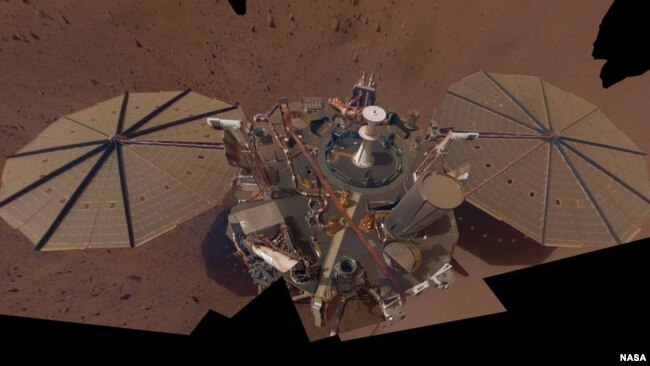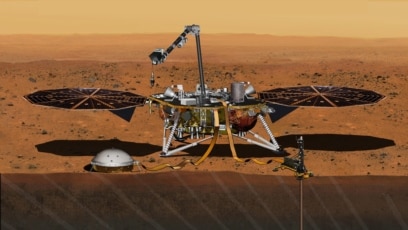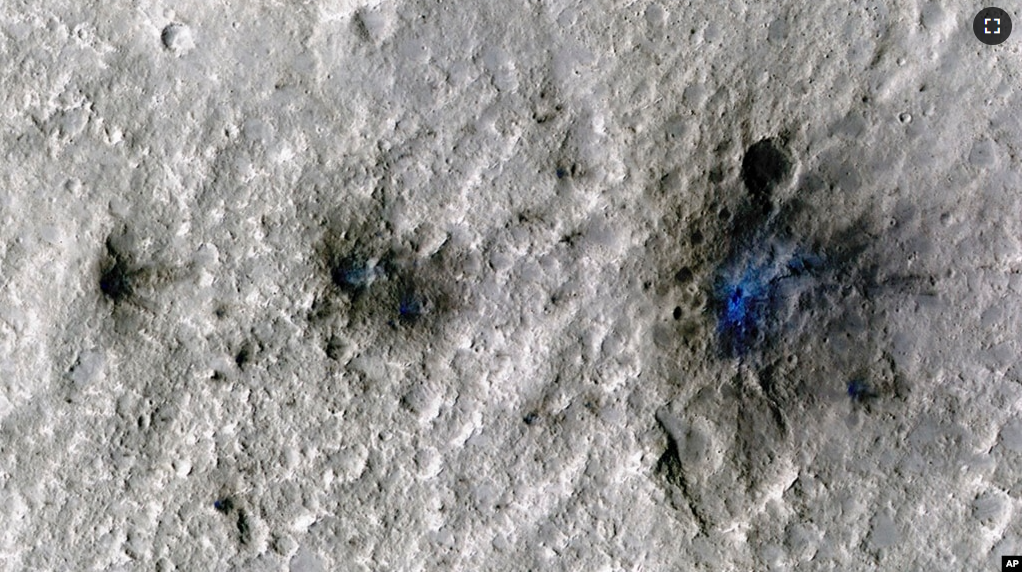Researchers say a spacecraft on Mars has recorded vibrations and sounds of space rocks hitting the planet.
The activity was picked up by a seismometer, an instrument that measures ground noises and shaking linked to earthquakes, volcanic eruptions and explosions.
The seismometer sits on the surface of Mars. It is connected to the InSight lander, which is operated by the American space agency NASA.
Scientists recently announced the instrument had discovered seismic waves from four different space rocks that crashed into Mars in 2020 and 2021.

The first of the four confirmed meteoroids entered Mars’ atmosphere on September 5, 2021, NASA said in a statement. Meteoroid is the term used for a space rock before it hits the ground. Once the rock or parts of it hit the surface, they are called meteorites.
The first rock to enter the atmosphere exploded into at least three pieces. Each of the pieces left craters on the surface. Researchers then estimated where the craters were. NASA even released recordings of what the meteoroid strikes sounded like.
Later, the team used NASA’s Mars Reconnaissance Orbiter to confirm the crater positions. The orbiter’s imaging instruments found three darkened spots on the surface.
InSight’s seismometer has already discovered numerous marsquakes on the Red Planet. A marsquake is a seismic event on Mars that is similar to earthquakes that happen on Earth.
But NASA said this was the first time scientists were able to confirm that these kinds of seismic and sound waves were linked to space rock strikes. The discovery also marks the first time that such seismic activity from strikes, also called impacts, has been measured on Mars.
Researchers recently published details on their findings in a paper in the publication Nature Geoscience.

Ingrid Daubar is a specialist on Mars impacts at Brown University in Rhode Island. She was a co-writer of the paper. Daubar said in a statement, “After three years of InSight waiting to detect an impact, those craters looked beautiful.”
NASA said the team used earlier data to also confirm three other impacts. One happened in May 2020, another in February 2021 and a third in August 2021.
Researchers have wondered why they have not detected more meteoroid strikes on Mars. After all, the planet sits next to the solar system’s main asteroid belt, which produces a large number of flying space rocks. In addition, the Mars atmosphere is just one percent as thick as Earth’s, meaning more meteoroids can pass through it without being destroyed.
Daubar said that on Mars, “hundreds of impact craters are forming somewhere on the planet’s surface every year.”
But NASA scientists say InSight lander’s seismometer may have been missing impacts because of interfering noise from the Martian wind or seasonal changes in the atmosphere.
The researchers believe the new findings could lead to many new impact discoveries based on InSight’s existing data that goes back to 2018, when the lander arrived on Mars.
Scientists say the study of seismic activity on Mars can help them better understand the materials contained below the planet’s surface.
“Impacts are the clocks of the solar system,” said Raphael Garcia, a lead writer of the paper and a scientist at France’s Higher Institute of Aeronautics and Space in Toulouse. “We need to know the impact rate today to estimate the age of different surfaces,” he said in a statement.
Garcia added that the same kind of instrument might also be used to make similar measurements on the moon. He said two French-built seismometers are expected to be included in a NASA lunar science mission that could launch in 2025.
I’m Bryan Lynn.
Bryan Lynn wrote this story for VOA Learning English, based on reports from NASA, The Associated Press, Reuters and Agence France-Presse.
Quiz – NASA Spacecraft Records Sounds of Space Rocks Hitting Mars

Start the Quiz to find out
___________________________________________________________________
Words in This Story
vibrate – v. to shake with small, quick movements
crater – n. a big hole in the ground created by the force of an object
detect – v. to find or discover
asteroid belt – n. the area of interplanetary space between the orbits of Mars and Jupiter in which most asteroids are found
